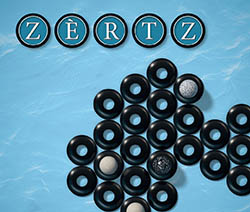
GIPF is a separate game and should, at first, always be seen as such. In addition, it is also the name of a project of which the game GIPF is the center.
This project consists of a series of games and a number of extra pieces that are all compatible with GIPF, which allows you to combine games and to decide for yourself what, exactly, you would like to play.
Concept
GIPF is the central game project GIPF. It is played solely with basic pieces, but you can add extra pieces to it, which means you can expand it. These extra pieces are called potentials. A potential is a piece that can be grafted onto the basic pieces you use to play GIPF.
A basic piece "loaded" with such potential will allow you to make a move which cannot be made with a normal basic piece. Each game of the project introduces its own new potential into GIPF.
Potentials can be used either as a number of special moves you may make while playing GIPF, or as a means to connect one or more games to GIPF. In the first case, you may make use of the extra strength of a potential at any moment while playing GIPF.

In the latter case you must win the like-named game to obtain the right to use a potential. For example: to be allowed to use a ZERTZ-potential, you first have to win a game of ZERTZ.
This means that you and your opponent interrupt the running game of GIPF to play a game of ZERTZ; the result will determine whether or not you may use the ZERTZ-potential when the game of GIPF is resumed.
The essence of this system is that you and your opponent have a number of pieces on the board that are loaded with particular possibilities. These possibilities are about special moves, but you are not sure that you will be allowed to execute them.
In other words: you play with pieces that might enable you to make a special move, which literally means that only the potential of such a move is available-not the move itself.

Possibilities
Maybe you will be tempted to conclude that the GIPF project is too complicated and too far-fetched a construction. That's why we stress that the possibility to combine games is nothing but an option. Forget all about it if it doesn't appeal to you.
Each game of the project stands on its own in terms of rules, concept and quality. It is exactly this ability of GIPF and all other GIPF-related games to be playable as separate contests of skill and as a complex composition of different strategic elements, that makes them a unique series.
So, whether you are an occasional player or a fanatic gamer, you are completely free to decide for yourself that you'll play the games separately or in connection with each other.
If you would like to make use of the possibility to combine them, you will discover a completely new way of playing. No other game offers so much variation. Each time, you and your opponent will be able to compose which version of GIPF you are going to play.
You can choose the number of basic pieces to start with and whether or not you are going to use potentials; if so, you can decide to both play with the same potentials or maybe you will each choose your favorite ones. You can then decide whether you connect the use of the potentials to playing other games or not, et cetera.
You can play for one or two hours, or you can take off into an entire evening of GIPF; you can play a straight-forward version or decide to go for a complex cluster of games; you can even make it an adventurous trip, spread over several game sessions.
In short, the project is a menu with components, by means of which you have the opportunity to choose d la carte which game of GIPF you would like to play at any moment.
GIPF can be combined with every existing two- person game, depending on how much time you have and what you feel like playing.
If you have a game of GIPF and at least one set of potentials, you can start combining the games you already have somewhere on a shelf, no matter what: Dominos, Ludo, or even just a deck of cards or an ordinary die. All you have to do is connect the use of a certain potential to a certain game, or cards or dice or whatever, and start playing.
Continue Reading

